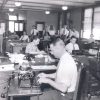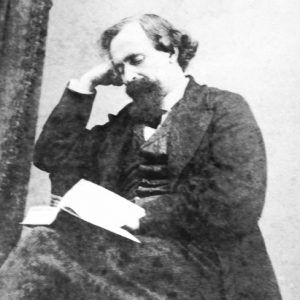calsfoundation@cals.org
Washington Telegraph
The Washington Telegraph newspaper operated in the Hempstead County town of Washington for more than a century, beginning circa 1840. The paper notably continued during the Civil War and reported on the Confederate state government that was based in Washington. When it ceased publication in 1946, it was the oldest weekly newspaper located west of the Mississippi River.
The Washington Telegraph was established by William Etter, a native of York County, Pennsylvania, who arrived in Hempstead County in 1839. The twenty-three-year-old brought a printing press and set up a newspaper in Washington. Some sources report that the first issue appeared in 1839, while others list the date as February 12, 1840. The paper was known as the first published in the state southwest of Little Rock (Pulaski County). Etter used a former tavern as an office, and the paper would remain under the ownership of the Etter family for the entire existence of the publication, although others often served as editors.
Many newspapers in the United States in the nineteenth century openly supported particular political parties or were operated directly by parties. The Washington Telegraph began as a politically independent newspaper but transitioned to supporting the Whig Party in the 1840s. With the failure of the Whigs in the 1850s, the paper began supporting the Democratic Party. The paper served the local community and residents spread across southwestern Arkansas. The first report that Jim Bowie’s namesake knife had been constructed in Washington appeared in the Telegraph in 1841.
During the secession crisis of 1861, the newspaper was edited by John Eakin, who initially opposed secession but changed to support the movement after the firing on Fort Sumter. Eakin served as the editor during the Civil War, ably keeping the paper in operation in the face of supply cuts that led to the brief printing of the newspaper on wallpaper. Eakin and Etter created a publishing company that obtained the printing contract for the Confederate state government. The newspaper included detailed announcements from both the state government and the military. It briefly ceased publication during the 1864 Camden Expedition when Washington was threatened by a Federal force but quickly returned to publication at the end of the campaign.
A number of notable editors served the newspaper over the decades. Eakin served as a state legislator, member of the 1874 Constitutional Convention, and member of the Arkansas Supreme Court. Confederate veteran Daniel Webster Jones served as editor years before being elected as governor in 1896. The first woman to serve as editor of the newspaper was Mrs. C. E. Ratcliffe, who served in the role in the 1890s.
In 1939, Hope (Hempstead County) became the county seat, and the population of Washington entered a steady decline. The Telegraph briefly merged with the Southwest Journal, a newspaper published in Hope and owned by William Etter IV, a member of the fourth generation of the Etter family to own the newspaper. Within a year, the publications separated, and both continued to be published. Publication of the Telegraph ceased in 1946 when Etter made the decision to stop supporting it with profits from his hardware business. He did continue to operate a printing press for contract jobs.
The newspaper is an important source for historians researching life in southwestern Arkansas, especially during the Civil War. Many issues of the newspaper have been digitized by the Arkansas State Archives as part of the Chronicling America project sponsored by the Library of Congress.
For additional information:
Dougan, Michael B. Community Diaries: Arkansas Newspapering, 1819–2002. Little Rock: August House, 2003.
Gwaltney, Francis Irby. “A Survey of Historic Washington, Arkansas.” Arkansas Historical Quarterly 17 (Winter 1958): 337–396.
Rhodes, Sonny. “Opposite Extremes: How Two Editors Portrayed a Civil War Atrocity.” American Journalism 22 (Fall 2005): 27–45.
Smith, Robert Freeman. “John R. Eakin: Confederate Propagandist.” Arkansas Historical Quarterly 12 (Winter 1953): 316–326.
“Washington Telegraph.” Chronicling America, Library of Congress. https://www.loc.gov/item/sn82014751/ (accessed September 20, 2025).
“The Washington Telegraph and the Print Museum.” Historic Washington State Park. https://www.arkansasstateparks.com/articles/washington-telegraph-and-print-museum (accessed September 20, 2025).
David Sesser
Southeastern Louisiana University
 Mass Media
Mass Media John Eakin
John Eakin 



Comments
No comments on this entry yet.